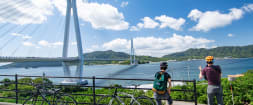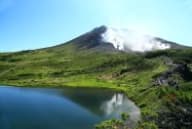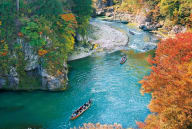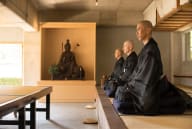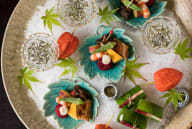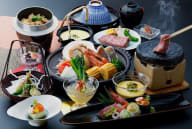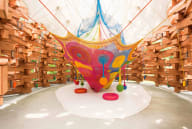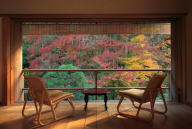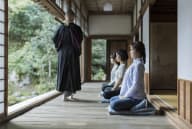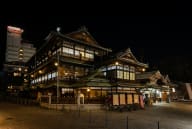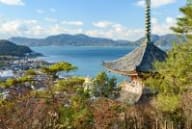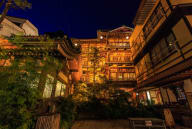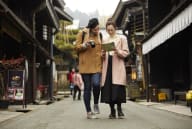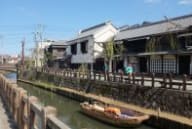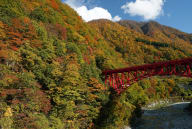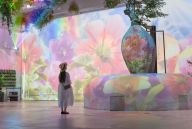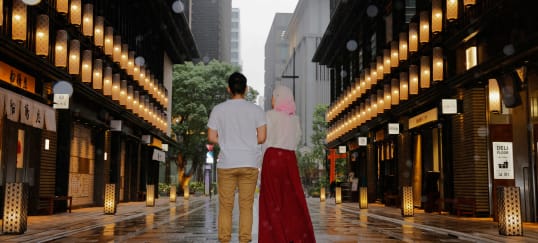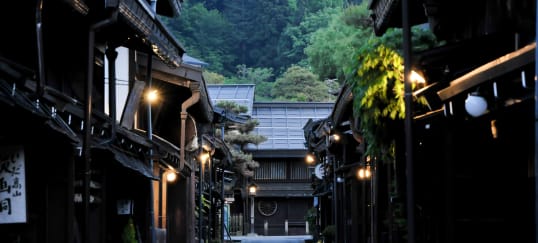Use the
Planning a Trip to Japan?
Share your travel photos with us by hashtagging your images with #visitjapanjp
Explore some of Tokyo's most verdant and historical sites while enjoying the best Muslim-friendly food the city offers.
Tokyo is a city that offers experiences that fascinate and amaze, leaving treasured lifelong impressions for those who visit. Malaysians will appreciate the city’s dedication to lush, green spaces that have been manicured to perfection by talented craftsmen old and new, leading to some of the most spectacular sights framed against the hypermodern backdrop of the city.

Hama-rikyu in autumn. Photo Credit: Tokyo Convention & Visitors Bureau
In this article, we take in the sights at some of Tokyo’s most notable green spaces while introducing some of the best Muslim-friendly restaurants nearby as recommended by our partner, Muslim Malaysian travel blogger and content creator Ashikin Amran. Be sure to add some of these destinations to your itinerary for your Tokyo trip to complete your experience!
Hama-rikyu Gardens (Shiodome)

Nakajima no Ochaya at Hama-rikyu Gardens. Photo Credit: Tokyo Convention & Visitors Bureau
Alongside the panoramic view of Tokyo Bay lies Hama-rikyu Gardens, a large and captivating landscaped garden steeped in tradition and culture. The garden features seawater ponds that change level with the tides and a variety of seasonal foliage such as maple, ginkgo, plum and cherry trees alongside flower fields that bloom nearly all year round. The garden can even be accessed via select Tokyo Water Buses from Asakusa.
Another notable highlight of the garden is the Nakajima no Ochaya floating teahouse, which was reconstructed in 1983. Visitors can relax at the teahouse and enjoy a bowl of matcha for a small fee while enjoying the view.
Originally built as an Edo Period feudal lord's Tokyo residence and duck hunting grounds, the garden’s legacy can still be seen in the reconstructed duck blinds that dot the garden, as well as remnants of an old moat and reconstructed rock wall.
Hama-rikyu Gardens (Website)
1-1 Hamarikyuteien, Chuo-ku, Tokyo 104-0046
How to get there: From JR Shimbashi Station, walk 12 minutes to Hama-rikyu Gardens.
Check out this restaurant:
Ninja Yakiniku is a short train ride from Hama-rikyu Gardens via the Oedo Line’s Tocho-Mae train and is 100% halal certified. The restaurant offers only A5 wagyu cuts for their dishes, including the renowned Iga phantom beef from Mie prefecture. Prayer rooms are available at the restaurant.
Ninja Yakiniku (Website)
1-16-11, 7F Asakusa, Taito-ku, Tokyo 111-0032
How to get there: From Hama-rikyu Gardens, head back to JR Shimbashi Station and take the Toei Asakusa Line to Asakusa Station. From Asakusa Station, take an 8-minute walk to the restaurant.
Meiji Shrine (Shibuya)

The gates of Meiji Shrine.
In the middle of lush metropolitan Tokyo lies the serene Meiji Shrine, a Shinto shrine dedicated to Emperor Meiji (1852-1912) and Empress Shoken. Upon passing the massive Torii gate that marks the beginning of the shrine grounds, the sounds of bustling Tokyo are replaced by the tranquility of the thousands of trees planted during the shrine’s construction, making the forest a peaceful respite from the city.
The grounds are also home to the Meiji Jingu Museum, which was opened in 2019 and houses treasures from the shrine's collection, including personal belongings of the emperor and empress. The carriage which the emperor rode to the formal declaration of the Meiji Constitution in 1889 is also housed in the museum.

Visitors pass through a torii gate at Meiji Shrine.
Should visitors plan to visit in June, there’s a special treat waiting in the shrine’s Inner Garden. Mid-June is when many irises are in bloom, and is a popular attraction for many local visitors.
Meiji Shrine (Website)
1-1 Yoyogikamizono-cho, Shibuya-ku, Tokyo 151-8557
How to get there: The shrine is a 1-minute walk from JR Harajuku Station.
Check out this restaurant:
SenSei MenKan offers a variety of halal Chinese food that will tingle the tastebuds. Staffed and run by Muslims, the owners guarantee that all dishes served are also alcohol-free. Dishes from China’s Shanxi province are offered there, including hot oil braised beef noodles, biangbiang noodles and more. Those looking for a nearby prayer space can board the Odayku Line at Shinjuku Station to Yoyogi-Uehara Station, where you can find Tokyo’s largest mosque, the Tokyo Camii.
SenSei MenKan (Website)
3-12-7 Takadanobaba, Shinjuku-ku, Tokyo 169-0075
How to get there: From Meiji Shrine, board the Yamanote Line at Yoyogi Station to Takadanobaba Station then walk for 7 minutes.
Tokyo Camii (Website)
1-19 Oyama-cho, Shinjuku-ku, Tokyo 151-0065
How to get there: From JR Shinjuku Station, take the Odakyu Line to Yoyogi-Uehara Station then walk for 5 minutes.
Sumida Park (Asakusa)

Sakura blossoms in bloom in Sumida Park at night. Photo Credit: 365ASAKUSA
Tokyo’s Asakusa district is usually a bustling hub of activity, but there is a scenic space for taking in both the wonders of Japan’s nature and craftsmanship: Sumida Park. Straddling both sides of the Sumida River, Sumida Park is a stretch of green that offers a unique view of the iconic Tokyo Skytree alongside sculptures, a playground, and even a dock where you can board the Tokyo Water Bus.
The park is a popular cherry blossom viewing spot in the spring and is touted as one of the best spots in Tokyo to watch fireworks in late July. The trees are also illuminated at night, making it a great place for an after-dinner stroll.

The Tokyo Skytree seen from Sumida Park. Photo Credit: 365ASAKUSA
Those looking to get a sweat in will also be glad to know that the park is equipped with athletic equipment and a jogging course.
Sumida Park (Website)
7-1 Asakusa, Taito-ku, Tokyo 111-0032
How to get there: Walk 5 minutes from Asakusa Station on the Tobu Skytree Line, Toei Asakusa Line, and Tokyo Metro Ginza Line.
Check out this restaurant:
Tempura Asakusa SAKURA offers rice flour-based gluten-free tempura batter and halal ingredients such as wagyu beef sirloin and live tiger prawns, all to be enjoyed in the sakura blossom-inspired setting of the restaurant. The restaurant also features an open kitchen, so you can watch your meals being prepared by the talented chefs. English-speaking staff are available at all operating hours, and walk-ins are entertained if seats are available.
Tempura Asakusa SAKURA (Website)
2−18−16, The City Asakusa Kaminarimon 7F, Kaminarimon, Taito-ku, Tokyo 111-0034
How to get there: From Sumida Park, head southwest and walk for 5 minutes.
Shinjuku Gyoen National Garden (Shinjuku)

Shinjuku Gyoen National Garden. Photo Credit: Shinjuku Gyoen Management Office
Originally part of Edo residence given to Lord Naito by Tokugawa Ieyasu, the garden was converted into a private imperial garden by the Meiji government in 1906.
Shinjuku Gyoen National Garden spans a massive 144 acres and is heralded as one of the best places to visit in Tokyo, featuring Japanese Garden, Landscape Garden, Formal Garden and a greenhouse with both tropical and subtropical flora.

Roses in bloom at Shinjuku Gyoen National Garden. Photo Credit: Shinjuku Gyoen Management Office
Visitors can expect to see a variety of cherry blossom trees blossom around the garden usually in between late March to early April, and golden autumnal maples expected around mid-November to mid-December.
The garden is also home to various facilities including a museum, rest areas with cafes serving Japanese pastries and sweets, and various areas for a picnic with a scenic view, should the mood take you.
※Drinking alcohol, smoking cigarettes and using sports equipment (except in the Kids Area) in the garden are prohibited.
Shinjuku Gyoen National Garden (Website)
11 Naito-machi, Shinjuku-ku, Tokyo 160-0014
How to get there: Walk for 5 minutes from Exit 1 of Shinjuku-gyoemmae Station of the Marunouchi Line.
Check out this restaurant:
Halal Ramen Honolu specialises in halal chicken ramen with halal soy sauce, and received their halal certification in 2020. This small and intimate restaurant seats 20 at any one time, and their special rich chicken flavor & spicy ramen combo is highly recommended. Do note that the restaurant does not accept credit cards, so bring some cash along for the trip.
Halal Ramen Honolulu Shinjuku Gyoen (Website)
1-31-3, Dia Palace B109, Shinjuku, Shinjuku-ku, Tokyo 160-0022
How to get there: Walk 7 minutes from Shinjuku Gyoen’s Okido Gate.
Todoroki Valley (Setagaya)

Todoroki Valley Walkway. Photo Credit: SETAGAYA
In the middle of the densely populated Setagaya City ward lies the Todoroki Valley. Following a picturesque walking trail that lasts for about one kilometer through a narrow, wooded valley along a small river, the trail takes about 20 to 30 minutes to complete and features waterfalls, temples, and shrines along the way.
One place of note along the trail is the Todoroki Fudoson, an ancient temple that boasts verdant springtime and autumn foliage and houses a wooden viewing platform that overlooks the valley for magnificent views. Visitors looking to take a break and take in the greenery can also stop by Setsugekka, an old sweetshop in the Todoroku Fudoson.
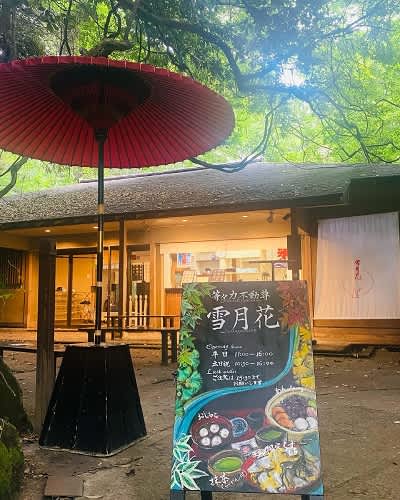
The traditional sweetshop Setsugekka in Todoroki Valley.
Remnants of tunnel tombs and geological rock strata viewing points are also scattered along the path, making for a trip through nature and time. Parts of the walking trail are currently closed due to damage caused by falling trees, and repairs are due to be finished in 2025. The trail has been opening progressively following maintenance and inspections on completed repairs. You may find the latest updates on the trail’s status on the Setagaya City website.
Todoroki Valley (Website)
1 Chome-22-26 Todoroki, Setagaya City, Tokyo 158-0082
How to get there: Walk 5 minutes from Todoroki Station on the Tokyu Oimachi Line.
Note: Some areas of the valley are closed due to maintenance work. Check the official website for more information.
Check out this restaurant:
Based in a 100-year-old Japanese house, Kosoan Tea House specializes in dessert and matcha tea. This charming teahouse features traditional decorations that will transport patrons back in time while enjoying treats like shaved ice and anmitsu. The Masjid Indonesia Tokyo is also a bus ride away from Todoroki Station to Moto Keibajo Mae bus stop for those looking for a convenient prayer space.
Kosoan Tea House (Website)
1-24-23 Jiyugaoka, Meguro-ku, Tokyo 152-0035
How to get there: From Todoroki Station, take the Tokyu Oimachi Line to Jiyugaoka Station then walk for 6 minutes.
Masjid Indonesia Tokyo (Website)
4-6-6 Meguro, Meguro-ku, Tokyo 153-0063
How to get there: From Todoroki Station, take a city bus to Moto Keibajo Mae bus stop and walk for 2 minutes.
Conclusion
Tokyo is filled with fascinating spots just like the ones on this list! Be sure to add some of these destinations to your itinerary for your visit and experience just how magical they can be—and in the midst of it, we hope you’ll find what you love about Japan.














